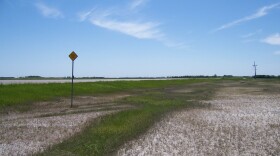I used to occasionally hear one of my college professors call out the names of some plants as he drove down the highway at 60 miles per hour. “That is a 60 mile-an-hour plant,” he would declare. One of those plants was curly dock, also known as curled dock, sour dock, or yellow dock.
Curly dock is an easy plant to identify this time of year. Dock looks like a tall dark brown weedy plant in road ditches and similar habitats during the fall. You may have noticed a rather large 1- to 3-foot-tall plant in the road ditches, largely consisting of several long dense clusters of small dark brown seeds (actually clusters of small winged fruits and seeds). It is almost certainly curly dock.
Curly dock belongs to the Buckwheat Family. There are around a dozen dock species that may be observed in North Dakota. They vary in habitat, size, and other characteristics, but all produce dense, similarly colored, clusters of fruits and seeds. Most of the docks are native, but curly dock is not. Generally considered to be a weed, curly dock was introduced from Eurasia and has become naturalized over much of North America. It can be observed across the state in disturbed areas, road ditches, fields, shorelines and similar sites.
The young leaves of dock during spring can be prepared and eaten much like spinach. They are reportedly a good source of vitamin A and C, but eating large amounts is not recommended because it may lead to an upset stomach. The plant has also been used as a herbal remedy for stomach issues (e.g., laxative) and as an antimicrobial. It is interesting to note that there is scientific evidence that the plant may have potential use as an antimalarial.
Dock is wind pollinated, so the plant is not an important plant to pollinators, although some insects will feed on the plant. And most mammals avoid it because it has a bitter taste. But several birds are known to feed on the seeds, including horned larks, song sparrows, prairie chickens, and redwing blackbirds.





